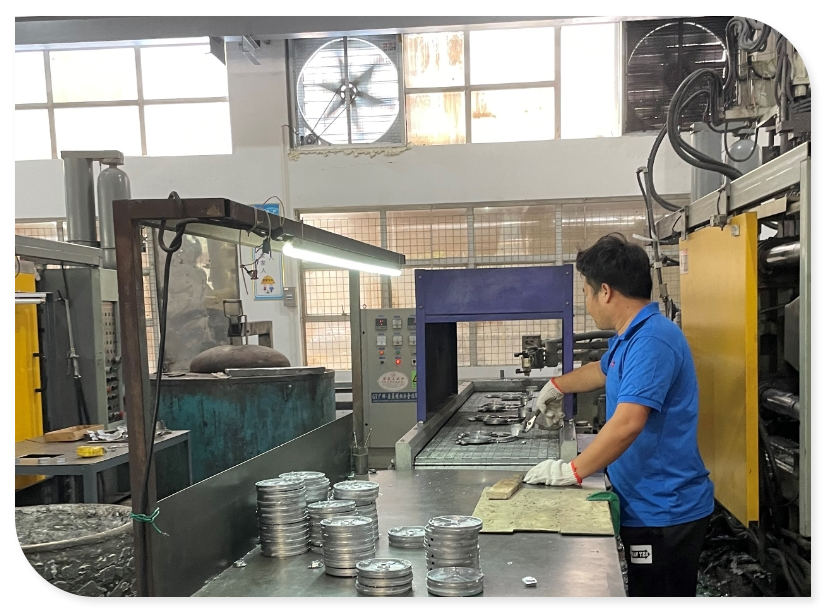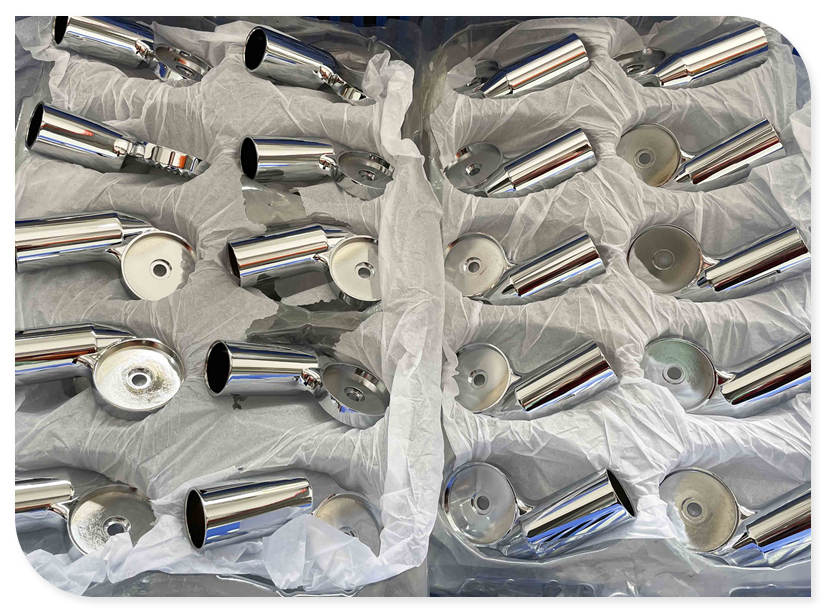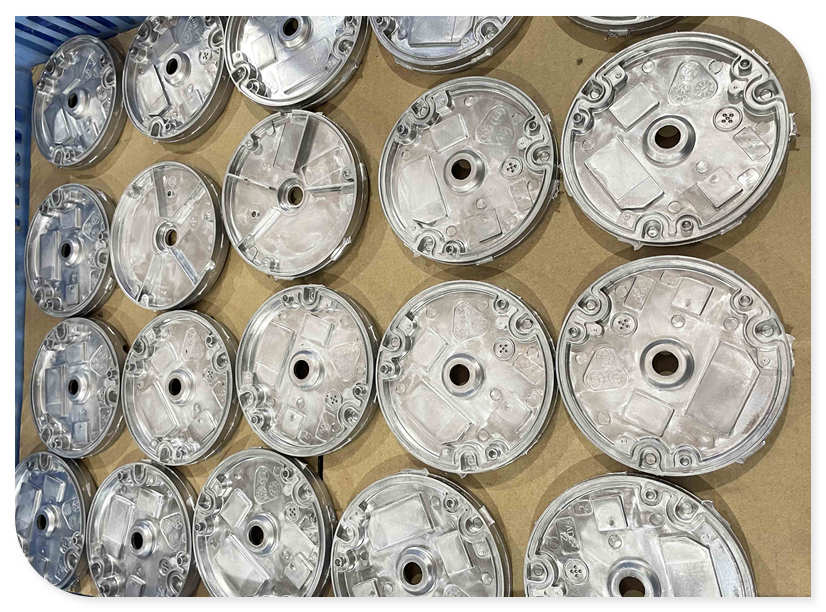|
Die Casting Moulds & Parts Manufacturing
Lyter also specializes in aluminum alloy die-casting, magnesium alloy die-casting, and zinc alloy die-casting. We have four Die Castings Machines in house that can support your Casting Die Parts production requirement. Our team commit to providing high-quality die-casting moulds and parts.
We believe that the accurate and reliable die casting molds are essential for mass production. Our mould manufacturing team has capacity to make die-casting moulds suitable for your hot-chamber and cold-chamber die-casting machines with a maximum clamping force of 1250 tons.
If you are looking for high quality, cost-effective and technological innovation, aluminum die-casting, magnesium die-casting, and zinc die-casting molds and parts, we can be your trusted partner. |
|
 |
|
|
|
Aluminum Die Casting Moulds & Parts Manufacturing Aluminum alloy die casting is to pour the molten aluminum alloy liquid into the pressing chamber, and the aluminum alloy liquid flows into the mold cavity under the action of high speed and high pressure, and then cooled and solidified into aluminum alloy die casting under the action of pressure.
The products made of aluminum alloy have high dimensional precision, good surface roughness, good casting stability, and high strength. Aluminum alloy dies castings have the characteristics of durability, corrosion resistance, good toughness, high strength, high electrical conductivity, non-magnetism, lightweight, and so on.
At present, aluminum alloy die casting products are mainly used in auto parts, electronic shell, communications, motor, aviation, ships, home appliances, furniture accessories, digital shell, handicrafts, security product shell, LED lighting (lampshade), and some new energy industries, etc.
Some high-performance, high-precision, high-toughness high-quality aluminum alloy die casting products are also used in large aircraft, ships, and other industries with higher requirements. Types: ADC12, A360, A380, A383, B390, A413. |
|
Zinc Casting Molds & Parts Manufacturing Die-casting zinc alloy is also a widely used die-casting alloy at present. Its main features are as follows. Die-casting zinc alloy has good die-casting performance and good fluidity, which can be used for die-casting parts with thinner wall thickness, which makes up for the weight effect caused by high density. Its crystallization temperature range is small, easy to form, not easy to stick mold, and easy to demoulding. The pouring temperature is lower and the service life of the die-casting die is longer. Zinc alloy has no corrosion effect on the die chamber and die casting mold parts in the range of pouring temperature. The shrinkage is small, so it is easy to ensure the dimensional accuracy of die castings. The comprehensive mechanical properties are higher, especially the compression resistance, and wear resistance is better.
Zinc alloy die casting surface can carry out a variety of anti-corrosion and decorative treatments, such as chemical treatment, anodizing, electroplating, electrostatic spraying, vacuum chromium plating, and so on. Types: ZA-2, ZA-3,ZA-4,ZA-5,ZA-7,ZA-8,ZA-12,ZA-27.
|
|
 |
 |
|
Magnesium Die Casting Tools & Parts Manufacturing The density of magnesium is 1.8 g / cm³, and that of aluminum alloy is 2.7 g / cm³. Magnesium alloy is the metal with the lowest density. The gravity of magnesium is around 2/3 of aluminum and 1/4 of iron. The phase relative strength (the ratio of strength to mass) of magnesium alloy is the highest. The specific stiffness (the ratio of stiffness to mass) is close to aluminum alloy and steel, and much higher than that of engineering plastics. Magnesium alloy has excellent properties such as strong earthquake resistance, electromagnetic resistance, thermal conductivity, and electrical conductivity, and can be fully recycled and pollution-free. Magnesium alloy is light in weight, its density is only 1.7kg/m3, its strength is higher than aluminum alloy and steel, its specific stiffness is close to that of aluminum alloy and steel, it can withstand the certain load, good casting performance, and dimensional stability, easy to process, low scrap rate, good damping coefficient, and large vibration damping than aluminum alloy and cast iron, so it is very suitable for automobile production. Also, it has wide applications in aerospace, portable computers, mobile phones, electrical appliances, sports equipment, and other fields. Types: AZ91b, AZ91D, AZ91HP, AM60A, AM60B. |








Die casting (also called pressure die casting) is a special metal casting process.
By pouring molten or semi-molten metal into the cavity of the casting machine, the metal liquid is filled into the die-casting mold cavity at high speed under high pressure, and the precision casting method is obtained through cooling and solidification.
This process is somewhat similar to injection molding. Most die castings are iron-free, such as zinc, copper, aluminum, magnesium, lead, tin, and lead-tin alloys and their alloys.
In general, there are 4 kinds of material for manufacturing a die casting mold. They are magnesium alloys, aluminum alloys, copper alloys, and zinc alloys.
1. For magnesium alloys, the commonly used grades are ZnAl4-1, ZnAl4-0.5, and ZnAl4.
2. For aluminum alloys, the commonly used grades are ZL101, ZL102, ZL103, ZL104, ZL105, ZL301, ZL302, and ZL401.
3. For copper alloys, the most commonly used grade is ZM5.
No matter which types of molds, we need to do the maintain regularly. And here are some tips to maintain the die casting molds for your reference.
1) Before operating a new die casting mold, we suggest you do the surface strengthening treatment.
2) You should do the first maintenance when the die casting mold comes to its 5,000 – 10,000 shots.
3) When the die casting mold reaches 30,000 shots, you should do the second maintenance.
4) The third maintenance shall take place at the time when the die casting mold comes to 50,000 shots.
1) Appearance inspection
Mold label and details are finished correctly, should include basic information such as mold number, press model, punch diameter, moving and fixed mold weight, supplier information etc. The identification of different numbers are clear and complete; the appearance is clean and no visible marks.
2)Dimension check
Check all dimensions to guarantee successful installation with the nominated machine.
© Copyright: 2025 Lyter Engineering Ltd. All Rights Reserved

IPv6 network supported